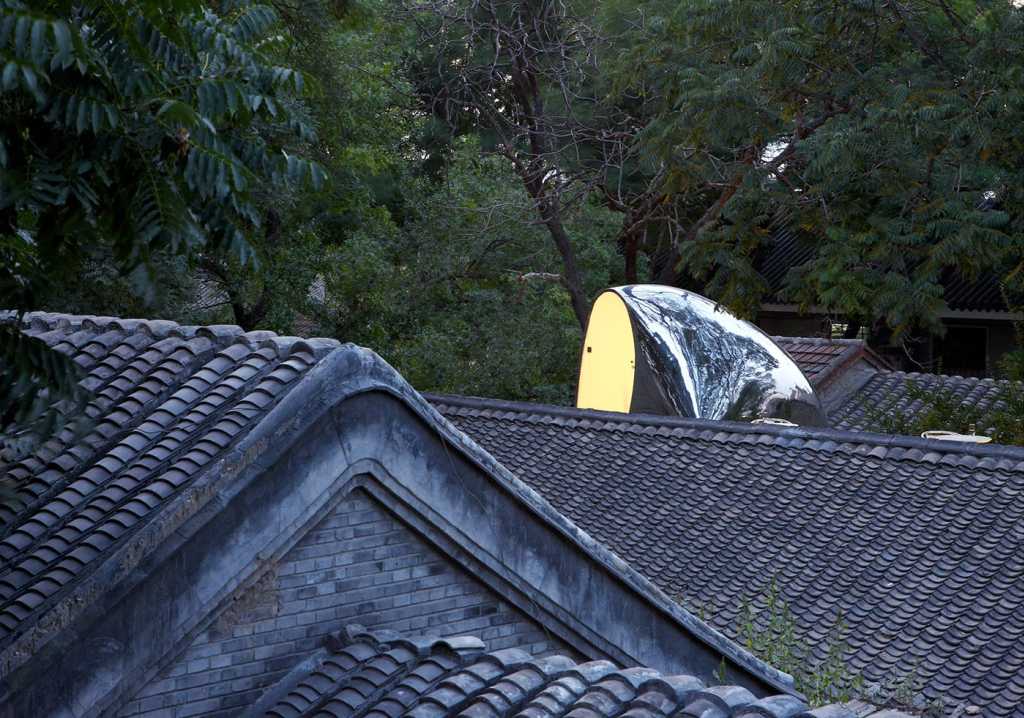MAD 建筑事务所:在2006年威尼斯建筑双年展期间,MAD的城市概念作品《北京2050》首次亮相于威尼斯个展MAD IN CHINA中。其中如同水滴一样散落在北京老城区的胡同泡泡,在三年之后,出现在位于北京老城区的北兵马司胡同32号的小院里。
MAD Architects:During the 2006 Venice architecture biennale, mad’s urban concept work ” Beijing 2050″ debuted in the Venice solo exhibition MAD IN CHINA.The bubbles scattered like drops of water in the hutong in the old city of Beijing appeared in the small courtyard at No. 32 north military forces hutong in the old city of Beijing three years later.
《北京2050》描绘了三个关于北京城市未来的梦想——一个被绿色森林覆盖的天安门广场,在北京CBD上空飘浮的空中之城,和植入到四合院的胡同泡泡。经济发展所推动的大规模城市开发,正在逐步逼近北京传统的城市肌理。陈旧的建筑,混乱的搭建,邻里关系的变迁,必要卫生设施的缺乏,导致这种原本美好安详的生活空间变成了很大的城市问题——四合院正在逐渐成了老百姓的地狱,有钱人的私密天堂,游客们的主题公园。
” Beijing 2050″ depicts three dreams about the future of Beijing city – Tiananmen square covered with green forests, an air city floating over Beijing CBD, and hutong bubbles implanted into quadrangles. The large-scale urban development promoted by economic development is gradually approaching the traditional urban texture of Beijing. Old buildings, chaotic structures, changes in neighborhood relations and the lack of necessary sanitation facilities have turned this originally beautiful and serene living space into a big urban problem – quadrangles are gradually becoming the hell of the common people, the private paradise of the rich and the theme parks of tourists.
面对这种源自城市细胞的衰退与滥用,需要从生活的层面去改变现实。并不一定要采取大尺度的重建,而是可以插入一些小尺度的元素,像磁铁一样去更新生活条件、激活邻里关系;与其他的老房子相得益彰,给各自以生命。同时这些元素应该具有繁殖的可能,在适应多种生活需求的基础上,通过改变局部的情况而达到整体社区的复苏。
Facing this kind of decline and abuse originating from urban cells, we need to change the reality from the level of life. It is not necessary to adopt large-scale reconstruction, but some small-scale elements can be inserted to update living conditions and activate neighborhood relations like magnets. Complement each other with other old houses and give their own lives. At the same time, these elements should have the possibility of reproduction. on the basis of adapting to various needs of life, they can achieve the recovery of the whole community by changing local conditions.
由此,世代生活在这里的居民可以继续快乐地生活在这里,这些元素也将成为历史的一部分,成为新陈代谢的城市细胞。
As a result, residents who have lived here for generations can continue to live happily here. these elements will also become part of history and become metabolic city cells.
出人意料的是,这种微观乌托邦的理想,在展览的三年之后便开始出现在了北京的四合院里。第一个《32号泡泡》是一个加建的卫生间和通向屋顶平台的楼梯,它看上去仿佛是一个来自外太空的小生命体,光滑的金属曲面折射着院子里古老的建筑以及树木和天空;让历史、自然以及未来并存于一个梦幻的世界里。
Surprisingly, this micro-utopian ideal began to appear in Beijing’s quadrangles three years after the exhibition. The first ” bubble 32″ is an added toilet and stairs leading to the roof platform. it looks like a small living body from outer space. the smooth metal curved surface reflects the ancient buildings in the courtyard, trees and sky. Let history, nature and the future coexist in a dream world.
胡同泡泡真正的城市理想是把北京的古城与每个人的梦想连接在一起, 在大刀阔斧的城市巨变中,我们必须重新思考北京长期的目标和想象力在哪里。也许我们可以把目光的焦点从那些大型的纪念碑式建筑移开,而开始关注人们日常生活的改善和社区生活的重建。
The real city ideal of hutong bubble is to connect the ancient city of Beijing with everyone’s dream. in the drastic changes in the city, we must reconsider where Beijing’s long-term goal and imagination are. Perhaps we can shift our focus away from those large monument buildings and begin to pay attention to the improvement of people’s daily life and the reconstruction of community life.
名 称:胡同泡泡32号
主持建筑师:马岩松,党群
设计团队:戴璞,于魁,Stefanie Helga Paul,何威,申江海
完成时间:2009年9月
建设地点:中国,北京
施工单位:北京纳德环境艺术设计有限公司
资料提供:MAD建筑事务所
Name: Hutong Bubble 32
Host architect: Ma Yansong, Dang Qun
Design team: Dai pu, Yu kui, stefanie Helga Paul, he Wei, Shen jianghai
Completion date: September 2009
Place of construction: Beijing, China
Construction unit: Beijing Nader environmental art design co., ltd.
Information provided: MAD Architects













0 Comments